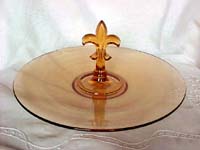National Depression Glass Association
Preserving America's Glass Manufacturing Heritage
What on earth is a sherbet plate?
Guide to collectible glass plate shapes
by Kathy Eickholt
As food options and lifestyles changed, the plates that people used changed too. We'll explain plates used in glass patterns from the 1920s through 1970s.
Sherbet Plate
Elegant glass companies in the 1920s and 30s had to overcome consumer resistance to the notion of eating off glass plates. Most people who could afford glass from hand houses such as Fostoria or Cambridge used china dinnerware. Yet the same consumer would happily buy glass stemware. One method glass firms used to gain acceptance was to market plates as liners under a stem. Thus the sherbet plate was born!
Sherbet or ice cream was a treat, often home made, that was served in special dishes. These look like little bowls on a stem, or like a short, wide goblet. These sherbets are not very stable if someone rested their spoon in them, so adding a plate underneath was a practical solution. Once finished eating, one could put the spoon on the plate and avoid spotting the tablecloth. Sherbet plates are about 6 inches in diameter in most patterns. They are about the same size as a saucer but don't have the inset to hold a cup.
Today we would use them as bread and butter plates or to hold a
small salad. Sherbet plates were common in the depression era, and
most 1950s-70s patterns call these small plates 'sherbet plates'.
 Our website shows Hocking's Block
Optic depression glass sherbet plates in green and yellow. You can
collect a rainbow of small glass plates. Each one is a small jewel,
showing the pattern perfectly in miniature.
Our website shows Hocking's Block
Optic depression glass sherbet plates in green and yellow. You can
collect a rainbow of small glass plates. Each one is a small jewel,
showing the pattern perfectly in miniature.
Grill Plate
Another plate type we don't see often today was the grill plate. Diners or cafes would use these plates because they made the food portions seem larger and made it easy to serve. Grill plates are divided, usually into three sections, and are about the same size as a dinner plate. In patterns such as Federal's Patrician depression glass one section is larger than the other two. Meat would go into the large section, possibly with potatoes, and a vegetable or roll would be in the other two. This was a practical way to keep food from running together. The photo at right is a grill plate in Fostoria's Fairfax pattern.
Only a few glass patterns such as Indiana's Daisy show grill plates after the depression. Because grill plates are practical and cute they are in some contemporary plastic or china sets meant for outdoor dining.
Chop Plate
Hocking's Waterford and Jeannette's Windsor were two patterns
that included chop plates. Today we would consider these very large
round platters and would serve food for a party or buffet. Chop
plates are round and about 13 inches in diameter. We show the
Windsor, Waterford and Floragold chop plates. Some later patterns
such as Christmas Candy had slightly smaller plates that were
called sandwich plates, usually 11 to 12 inches across. Be  careful
with the term sandwich plate, though, as there are similar terms
for other shapes.
careful
with the term sandwich plate, though, as there are similar terms
for other shapes.
Sandwich Server
Sandwich servers usually are plates with a handle in the center. Some handles are elaborate while others are fairly plain, and the base is often cut or etched. I've always felt these look like they should hold tiny cookies or petis fours. The sandwich server in the picture is from Fostoria and was made in the late 1920s. You may see sandwich servers called center-handled plates, sandwich plates, center-handled trays and so on. These are fun pieces that are both fancy and useful, and so evocative of the depression and elegant era.
Tort Plate
Torte plates were large and flat, sometimes with a foot or short pedestal. I have a beautiful torte plate in Indiana Glass' Double Fleur de Lis with a silver encrusted basket and flower design. The torte plates were impressive ways to serve dessert and were large enough to hold a 9 inch dessert.
Cake Plate
Cake plates also were flat and came in several shapes. Some patterns, such as Jeannette's Harp, were pedestal plates. The flat top was about 10 inches in diamter and stood on a 3-4 inch pedestal. Federal Glass' Sharon pink cake plate on our website has three small tab feet and is flat and round. It does not have an indentation for a cake cover. Jeannette's Anniversary has the same three feet, shape and size, but does have an indentation for the cover. Anniversary was made after the depression and works very well with the gaily decorated cake covers from the 1940s and 50s. The footed style is easier to store safely than the pedestal style. You may find cake plates in amber Madrid depression pattern that were made by gluing a candleholder to a plate; these were made when the Madrid molds were re-introduced in the 1970s under the name "Recollection".
Webmaster's NOTE: The NDGA wishes to thank the author for permission to use this article. Kathy is a dealer from Midland, Michigan. Her web site is Cat Lady's Glass.